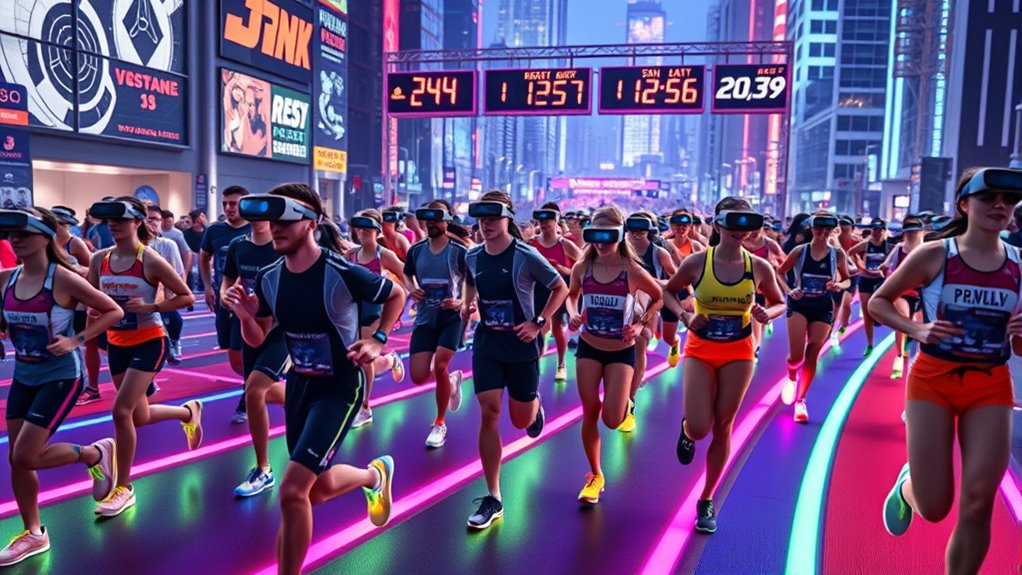The rise of virtual races lets you participate from anywhere, offering unmatched flexibility and inclusivity. You can choose your own course, set your pace, and run anytime that fits your schedule. Advanced technology makes registration, tracking, and sharing your achievements easy, creating a connected community despite physical distance. These events focus on personalization and enjoyment, shifting goals from just finishing to staying active and engaged. Keep exploring to learn how virtual races continue evolving and transforming your running experience.
Key Takeaways
- Virtual races offer flexible participation from home, broadening access for runners of all levels.
- Technology-driven platforms enable seamless registration, progress tracking, and community sharing.
- They foster community engagement through interactive features like leaderboards, social sharing, and live events.
- Customization options allow runners to choose their terrain, pace, and race environment, enhancing personalization.
- The format shifts focus from competition to health, inclusivity, and staying connected globally.

Have you ever wondered how you can participate in a race without leaving your home or neighborhood? The rise of virtual races has made that possible, transforming the way people engage with running events. Thanks to innovative race organization, these events are designed to be accessible, flexible, and engaging, allowing you to compete from anywhere in the world. Instead of the traditional race-day chaos, virtual races give you the freedom to choose your own course, set your own pace, and participate at a time that fits your schedule. This shift has broadened participation, making it easier for beginners and seasoned runners alike to join in the excitement.
Race organizers have adapted quickly to this new trend, focusing on seamless participant engagement. They leverage technology to create interactive platforms where you can register, track your progress, and share your achievements. Many virtual races provide official bibs, medals, and digital certificates, mimicking the feel of a traditional race but with added convenience. Some organizers even incorporate social features, encouraging you to post photos, comment on others’ progress, and cheer each other on throughout the event. These elements help foster a sense of community and competition, even if you’re miles apart from fellow participants.
Participant engagement is at the core of virtual race success. Organizers often send regular updates, motivational messages, and tips to keep you motivated. They might host live virtual events like pre-race warm-ups or post-race celebrations, helping you feel connected to a larger community. Many races also include interactive leaderboards that display real-time results, giving you a sense of achievement and healthy competition. This constant communication and transparency encourage you to stay committed and make the experience more personal and rewarding.
Moreover, virtual races open up opportunities for customization. You can choose your preferred terrain, whether it’s on a treadmill, city streets, or trails, and set your own pace. This flexibility helps you integrate running into your daily routine without the pressure of official start times or crowded corrals. You also have the freedom to participate alone or with friends and family, turning your race into a shared experience even if you’re physically apart. The focus shifts from simply finishing to enjoying the process, celebrating progress, and feeling connected through shared participation.
In essence, the evolution of race organization and participant engagement in virtual races has redefined how we think about competitions. It’s no longer just about crossing a finish line; it’s about creating an inclusive, interactive, and personalized experience that motivates you to stay active and connected. Whether you’re a seasoned athlete or just starting out, virtual races offer a new way to challenge yourself and be part of a global running community—all from your own neighborhood or home. This shift is also supported by advancements in interactive platforms, which enhance the overall user experience.]
Frequently Asked Questions
How Do Virtual Races Impact Local Running Communities?
Virtual races can boost your local running community by increasing community engagement and encouraging more participation. They also support local business support, as runners often buy gear, snacks, and other essentials from nearby stores. While they might reduce face-to-face interactions, virtual races foster a sense of togetherness online, inspiring runners to stay active and connected. This shift helps strengthen your community, making it more vibrant and supportive for everyone.
What Safety Concerns Are Associated With Virtual Races?
When participating in virtual races, you should be aware of safety concerns like runner safety and equipment concerns. Make sure your route is safe, well-lit, and familiar to prevent accidents or injuries. Check your equipment, such as shoes and GPS devices, to verify they’re functioning properly. Stay aware of your surroundings, hydrate, and wear reflective gear if running in low light, to keep yourself safe during the race.
How Do Virtual Races Affect Traditional Race Event Economies?
Virtual races can cause economic disruption for traditional race events by shifting participant engagement and revenue streams. You might see fewer in-person attendees, reducing ticket sales and local spending. Sponsorship dynamics also change, as brands may prefer the broader reach of virtual platforms over local event sponsorships. This shift challenges organizers to adapt their revenue models and find new ways to attract sponsors and participants in a competitive digital landscape.
Can Virtual Races Motivate Long-Term Fitness Habits?
Yes, virtual races can boost your fitness motivation and help with habit formation. They offer flexible scheduling, allowing you to run whenever it fits into your routine. By setting personal goals and tracking progress online, you stay accountable and committed. Over time, these consistent activities become habits, encouraging you to maintain a healthier lifestyle even after the race ends. Virtual races make long-term fitness achievable and engaging.
What Technological Challenges Do Virtual Races Face?
You face frequent frustrations with technology glitches and data security dilemmas. Virtual races wrestle with weaving through weak Wi-Fi, ensuring seamless streaming, and safeguarding sensitive personal data. Accessibility issues also persist, making it tough for everyone to participate equally. To triumph over these trials, you need reliable, robust tech that secures your information and makes participation simple and satisfying for all skill levels and devices.
Conclusion
As you embrace virtual races, you’re not just running on a screen—you’re weaving a tapestry of determination and community across miles. These races are like bridges connecting you to others, no matter where you are. With every step, you carve your story into the digital landscape, proving that the spirit of racing transcends physical finish lines. So, lace up your virtual shoes and let your journey paint the sky with your dreams.








